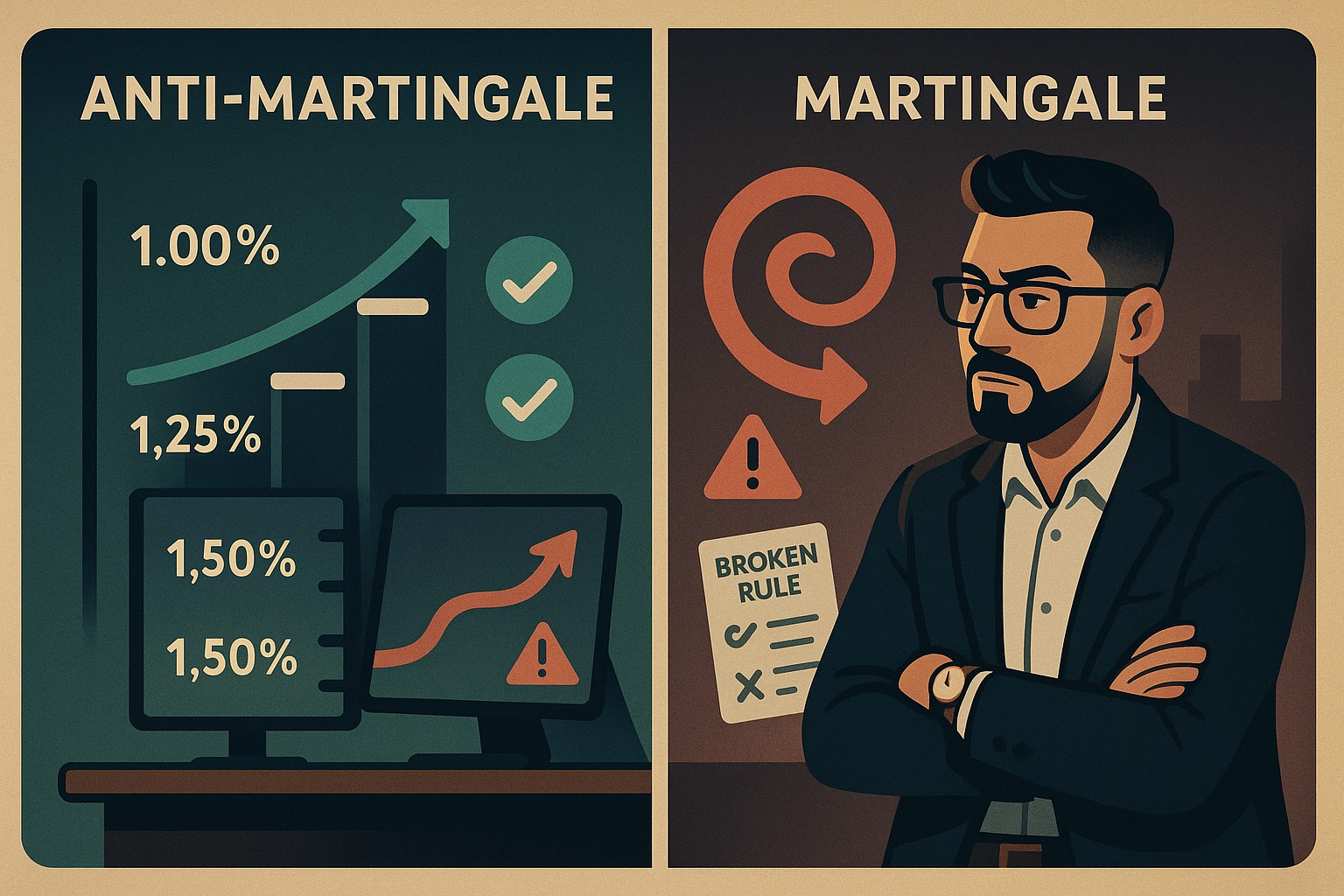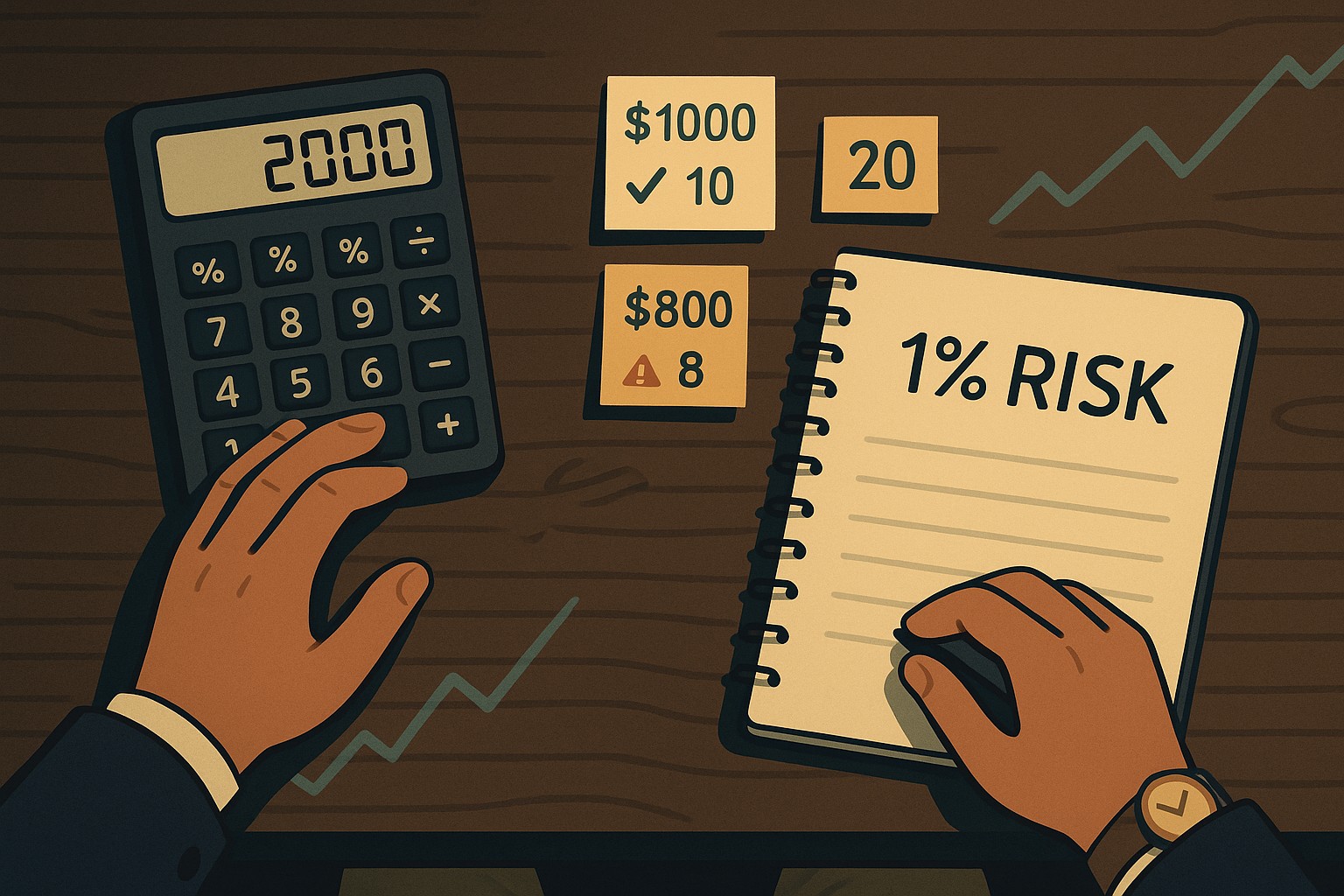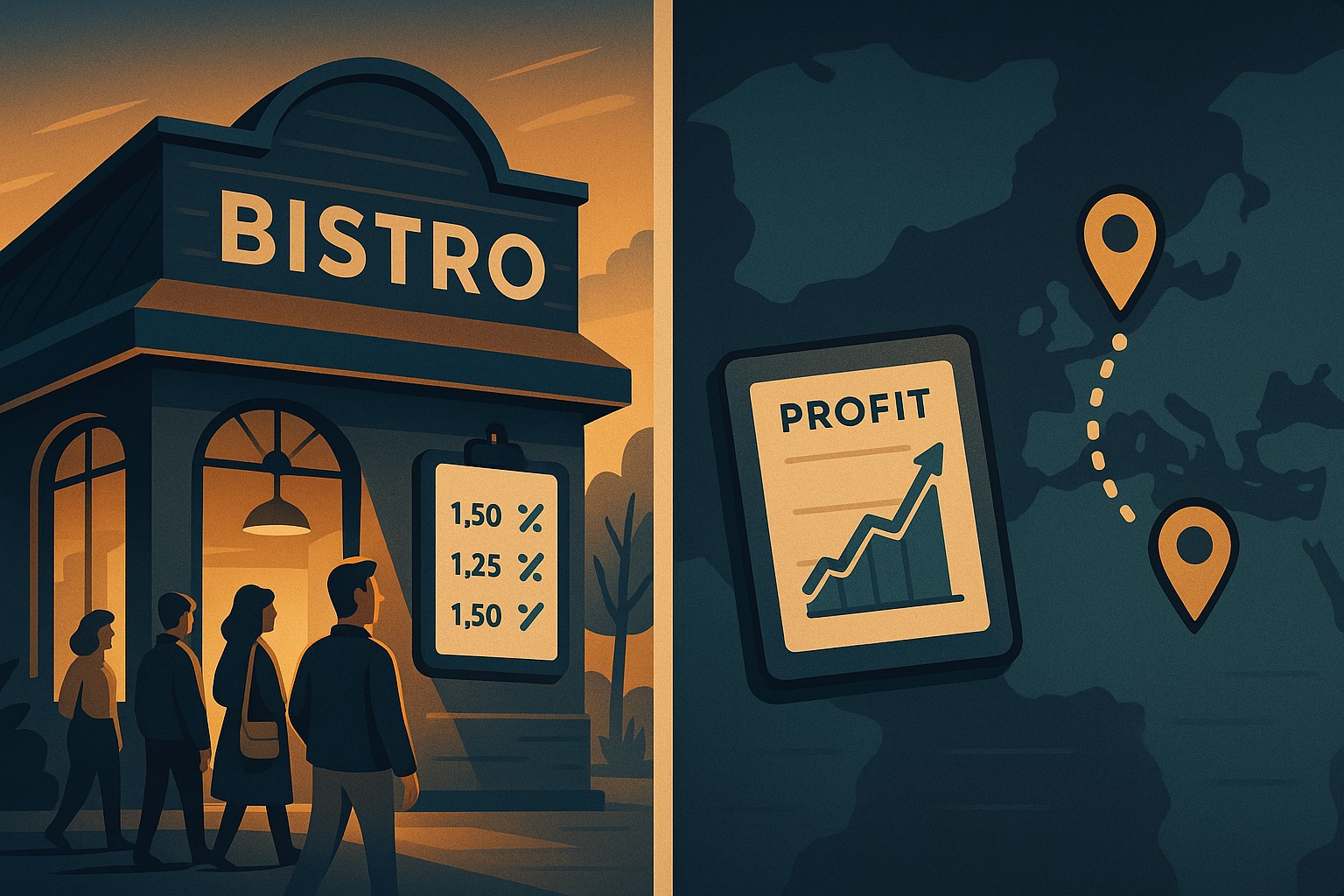Scaling Your Edge: From Small Account to Consistency
2025-09-26 10:00:33
The dream for many traders is to scale from a small account into something much bigger. For some, that vision looks like passing evaluations; for others, it’s compounding their own capital until trading becomes a meaningful income stream. Here’s the reality though: the true target isn’t a larger account - it’s consistency. Without it, more size only magnifies mistakes. With it, growth becomes a logical byproduct of process.

Scaling your edge is not about racing to prove yourself. It’s about building a track record of steady execution, risk discipline, and psychological resilience. Just as no business expands to new branches before the first location proves reliable, no trader should scale until their foundation is rock solid. If you want a practical primer on how professionals protect that foundation, start with this high-level risk management compilation and keep it bookmarked as your north star.
Why Consistency Is the Real Currency
It’s easy to think, “If only I had more capital, I’d finally make this work.” Capital isn’t the bottleneck - discipline is.
- A trader who lacks consistency on a $1,000 account will struggle even more on a $100,000 account. The mistakes don’t vanish; they get louder.
- A consistent trader can operate at almost any account size because results flow from a repeatable process, not a lucky streak.
Consistency proves your strategy is robust, your risk management is sound, and your psychology can handle market swings. This is where measuring your edge matters. Before anything else, learn to track expectancy, win/loss distribution, and drawdown behavior with clarity using Measuring Your Edge: Metrics That Matter. Those metrics become your dashboard for every scaling decision afterward.
The Trap of Chasing Size Too Early
Most traders chase size long before they’re ready. Ads shout “go bigger,” friends post highlight trades, and FOMO creeps in. The danger is simple:
- More size magnifies errors. A 1% mistake on $1,000 is $10. On $100,000, it’s $1,000 - and the emotional load is 100x heavier.
- Scaling without proof creates pressure. You start trading your fear of losing rather than your plan.
- Capital without consistency is unstable. It’s like expanding a restaurant chain when the first branch is still losing money. You multiply problems, not profits.
At this stage, you need clean data - not hopes. Build that data step by step: first backtest without bias to get a baseline, then forward test live with small size to prove your rules under uncertainty. Only then should you consider dialing up risk.
Risk Scaling Models for Traders

There are two practical frameworks that keep scaling sensible and aligned with performance.
1. Anti-Martingale Model - Grow With Wins
This model is built on strength. Instead of chasing losses, you gradually increase risk only after your system demonstrates stability.
- Start with 1% per trade during your baseline period.
- After hitting a clear milestone - say 50 to 100 trades with positive expectancy and controlled drawdown - step modestly to 1.25%.
- Keep increases incremental and earned.
This approach rewards consistency rather than emotion. If you’re curious about when “adding size” becomes reckless, study how martingale thinking sneaks in and why it’s dangerous via Martingale Strategy in Trading: Double-Edged Sword?.
2. Fixed Fractional Model - Safe, Automatic Compounding
This method is simple and durable: risk a fixed percentage of equity (e.g., 1%) every trade.
- On $1,000, 1% risk is $10; on $2,000, it’s $20; on $800, it drops to $8.
- Your risk shrinks in drawdown and grows with equity - automatically.
If you want to operationalize this, pair it with a clear plan for sizing and execution using Mastering Position Sizing and calibrate your baseline risk with How Much Should You Risk per Trade?.
When to Scale: Let the Data Decide

Scaling shouldn’t come from a feeling - it should come from proof. Before you increase size, your trading record should show:
- Positive expectancy over at least 50–100 trades.
- Stable drawdowns within your predetermined limits.
- Rule adherence, especially during losing streaks.
If your results are unstable with small size, scaling will only magnify instability. If they’re consistent, stepping up becomes a logical continuation of what already works. This is also where survival math matters - revisit Risk of Ruin to ensure your system’s parameters give you a statistically durable path as you scale.
The Psychology of Scaling
Scaling isn’t just numbers - it’s a mindset stress test.
- Emotions scale with money. Losing $50 feels different from losing $500, even if both are 1%. That emotional gap is where rule-breaking begins.
- Patience gets tested. Bigger size amplifies the temptation to “force” outcomes. Your discipline has to grow alongside your position size.
- Identity drives behavior. You’re not chasing a quick win; you’re operating a professional process. That identity should be reflected in your routine, your journaling, and your risk standards day after day.
A practical way to anchor this mindset is to adopt a rules-first approach to moving averages and trend context - they help you act on structure, not impulses. For a crisp systems overview to keep your thinking organized, see the Moving Averages Strategy Playbook.
Real-Life Analogy - Expanding a Restaurant

Imagine a small restaurant. At first, the focus isn’t franchising; it’s getting the basics right - serving great food, managing costs, and building a loyal customer base. If the restaurant runs at a loss, opening two more locations won’t fix it. You’d only multiply losses. But if the single branch runs smoothly and profitably month after month, expansion becomes a natural next step.
Trading works the same way. Your small account is that first branch. Your trade journal is the profit-and-loss statement. If the statements prove reliability, scaling is no longer a gamble - it’s a reflection of consistency. And if you want to refine edges without breaking what works, keep iterating intelligently with Refining Your Edge - Iteration Without Overfitting so your improvements stay grounded in reality, not curve-fit fantasies.
Final Thoughts

Scaling your edge is not a sprint - it’s a reflection of mastery. If you can execute with discipline, respect risk, and prove consistency on a small account, scaling stops being about hope and starts being about logic. The only voice that should decide is your data. Your records must speak louder than your emotions, and your risk plan has to protect the base so your wins can compound.
Here’s a simple challenge for this week: audit your last 50 trades. Note your expectancy, your largest drawdown, and any rule breaks. Then answer this honestly: would you be comfortable running that same performance at 1.25x size without changing your behavior? If not, tune the process before you touch the size. If yes, you’re already doing the real work that makes growth possible.
Start Practicing with Confidence - Risk-Free!
- Trade forex, indices, gold, and more
- Access ACY, MT4, MT5, & Copy Trading Platforms
- Practice with zero risk
It’s time to go from theory to execution - risk-free.
Create an Account. Start Your Free Demo!
Check Out My Contents:
Strategies That You Can Use
Looking for step-by-step approaches you can plug straight into the charts? Start here:
- How To Trade & Scalp Indices at the Open Using Smart Money Concepts (SMC)
- How to Trade Breakouts Effectively in Day Trading with Smart Money Concepts
- Complete Step-by-Step Guide to Day Trading Gold (XAU/USD) with Smart Money Concepts (SMC)
- The Power of Multi-Timeframe Analysis in Smart Money Concepts (SMC)
- Forex Trading Strategy for Beginners
- Mastering Candlestick Pattern Analysis with the SMC Strategy for Day Trading
- How to Use Fibonacci to Set Targets & Stops (Complete Guide)
- RSI Divergence Trading Strategy for Gold: How to Identify and Trade Trend Reversals
- Stochastics Trading Secrets: How to Time Entries in Trending Markets using Stochastics
- Gold Trading Stochastics Strategy: How to Trade Gold with 2R - 3R Targets
- RSI Hidden Divergence Explained: How to Spot Trend Continuations Like a Pro
- Moving Averages Trading Strategy Playbook
- Mastering Fibonacci Trading Psychology - Trusting the Levels, Managing the Mind
- Mastering Price Action at Key Levels - How to Spot, Trade, and Win at the Most Crucial Zones
- Mastering Retests: How to Enter with Confirmation After a Breakout
Indicators / Tools for Trading
Sharpen your edge with proven tools and frameworks:
- The Ultimate Guide to Risk Management in Trading - A Complete Compilation for 2025
- Moving Averages Trading Strategy Playbook
- How to Think Like a Price Action Trader
- Mastering Fibonacci Trading Psychology - Trusting the Levels, Managing the Mind
How To Trade News
News moves markets fast. Learn how to keep pace with SMC-based playbooks:
- Why Smart Money Concepts Work in News-Driven Markets - CPI, NFP, and More
- How to Trade NFP Using Smart Money Concepts (SMC)-A Proven Strategy for Forex Traders
- How to Trade CPI Like Smart Money - A Step-by-Step Guide Using SMC
Learn How to Trade US Indices
From NASDAQ opens to DAX trends, here’s how to approach indices like a pro:
- How to Start Trading Indices and Get into the Stock Market with Low Capital (2025 Guide)
- Best Indices to Trade for Day Traders | NASDAQ, S&P 500, DAX + Best Times to Trade Them
- How To Trade & Scalp Indices at the Open Using Smart Money Concepts (SMC)
- NAS100 - How to Trade the Nasdaq Like a Pro (Smart Money Edition)
How to Start Trading Gold
Gold remains one of the most traded assets - - here’s how to approach it with confidence:
- How to Swing Trade Gold (XAU/USD) Using Smart Money Concepts: A Simple Guide for Traders
- Complete Step-by-Step Guide to Day Trading Gold (XAU/USD) with Smart Money Concepts (SMC)
- The Ultimate Guide to Backtesting and Trading Gold (XAU/USD) Using Smart Money Concepts (SMC)
- Why Gold Remains the Ultimate Security in a Shifting World
- How to Exit & Take Profits in Trading Gold Like a Pro: Using RSI, Range Breakdowns, and MAs as Your Confluence
How to Trade Japanese Candlesticks
Candlesticks are the building blocks of price action. Master the most powerful ones:
- Mastering the Top Japanese Candlesticks: The Top 5 Candlesticks To Trade + Top SMC Candlestick Pattern
- How to Trade Candlestick Patterns with High Probability: A Complete Guide for Beginners
- The Top Japanese Candlestick Guide: What is an Engulfing Pattern and How to Trade It?
- Piercing Pattern Candlestick Explained: How to Trade It - Step-By-Step Guide
- Morning & Evening Star Candlestick Patterns - How to Trade Market Reversals with Confidence
How to Start Day Trading
Ready to go intraday? Here’s how to build consistency step by step:
- 5 Steps to Start Day Trading: A Strategic Guide for Beginners
- 8 Steps How to Start Forex Day Trading in 2025: A Beginner’s Step-by-Step Guide
- 3 Steps to Build a Trading Routine for Consistency and Discipline - Day Trading Edition
- The Ultimate Guide to Understanding Market Trends and Price Action
- Trading with Momentum: The Best Trading Session to Trade Forex, Gold and Indices
Learn how to navigate yourself in times of turmoil
Markets swing between calm and chaos. Learn to read risk-on vs risk-off like a pro:
- How to Identify Risk-On and Risk-Off Market Sentiment: A Complete Trader’s Guide
- How to Trade Risk-On and Risk-Off Sentiment - With Technical Confirmation
- The Ultimate Guide to Understanding Market Trends and Price Action
Want to learn how to trade like the Smart Money?
Step inside the playbook of institutional traders with SMC concepts explained:
- Why Smart Money Concepts Work: The Truth Behind Liquidity and Price Action
- Mastering the Market with Smart Money Concepts: 5 Strategic Approaches
- Understanding Liquidity Sweep: How Smart Money Trades Liquidity Zones in Forex, Gold, US Indices
- The SMC Playbook Series Part 1: What Moves the Markets? Key Drivers Behind Forex, Gold & Stock Indices
- The SMC Playbook Series Part 2: How to Spot Liquidity Pools in Trading-Internal vs External Liquidity Explained
- Fair Value Gaps Explained: How Smart Money Leaves Footprints in the Market
- Accumulation, Manipulation, Distribution: The Hidden Cycle That Runs Every Market
- Institutional Order Flow - Reading the Market Through the Eyes of the Big Players
- London Session Trading Secrets: How Smart Money Sets the High & Low of the Day
- Mastering the New York Session - Smart Money Concepts Guide
Master the World’s Most Popular Forex Pairs
Forex pairs aren’t created equal - - some are stable, some are volatile, others tied to commodities or sessions.
- The Top 5 All-Time Best Forex Pairs to Trade
- Top Forex Pairs Beyond the Big Five
- EUR/USD: The King of Forex
- USD/JPY: The Fast Mover
- GBP/USD: The Volatile Cable
- AUD/USD: The Commodity Currency
- USD/CAD: The Oil-Backed Pair
- GBP/JPY: How to Trade The Beast
- Asian & London Session Secrets
- Mastering the New York Session
Stop Hunting 101
If you’ve ever been stopped out right before the market reverses - - this is why:
- Stop Hunting 101: How Swing Highs and Lows Become Liquidity Traps
- Outsmarting Stop Hunts: The Psychology Behind the Trap
- How to Lessen Risk From Stop Hunts in Trading
- How Stop Hunts Trigger Revenge Trading - Breaking the Pain Cycle
- How to Accept Stop Hunts Without Losing Discipline - Shifting From Frustration to Focus
Trading Psychology
Mindset is the deciding factor between growth and blowups. Explore these essentials:
- The Mental Game of Execution - Debunking the Common Trading Psychology
- Managing Trading Losses: Why You Can Be Wrong and Still Win Big in Trading
- The Hidden Threat in Trading: How Performance Anxiety Sabotages Your Edge
- Why 90% of Retail Traders Fail Even with Profitable Trading Strategies
- Top 10 Habits Profitable Traders Follow Daily to Stay Consistent
- Top 10 Trading Rules of the Most Successful Traders
- Top 10 Ways to Prevent Emotional Trading and Stay Disciplined in the Markets
- Why Most Traders Fail - Trading Psychology & The Hidden Mental Game
- Emotional Awareness in Trading - Naming Your Triggers
- Discipline vs. Impulse in Trading - Step-by Step Guide How to Build Control
- Trading Journal & Reflection - The Trader’s Mirror
- Overcoming FOMO & Revenge Trading in Forex - Why Patience Pays
- Risk of Ruin in Trading - Respect the Math of Survival
- Identity-Based Trading: Become Your Trading System for Consistency
- Trading Psychology: Aligning Emotions with Your System
- Mastering Fear in Trading: Turn Doubt into a Protective Signal
- Mastering Greed in Trading: Turn Ambition into Controlled Growth
- Mastering Boredom in Trading: From Restless Clicking to Patient Precision
- Mastering Doubt in Trading: Building Confidence Through Backtesting and Pattern Recognition
- Mastering Impatience in Trading: Turn Patience Into Profit
- Mastering Frustration in Trading: Turning Losses Into Lessons
- Mastering Hope in Trading: Replacing Denial With Discipline
- When to Quit on Trading - Read This!
- The Math of Compounding in Trading
- Why Daily Wins Matter More Than Big Wins
- Scaling in Trading: When & How to Increase Lot Sizes
- Why Patience in Trading Fuels the Compounding Growth
- Step-by-Step Guide on How to Manage Losses for Compounding Growth
- The Daily Habits of Profitable Traders: Building Your Compounding Routine
- Trading Edge: Definition, Misconceptions & Casino Analogy
- Finding Your Edge: From Chaos to Clarity
- Proving Your Edge: Backtesting Without Bias
- Forward Testing in Trading: How to Prove Your Edge Live
- Measuring Your Edge: Metrics That Matter
- Refining Your Edge: Iteration Without Overfitting
- The EDGE Framework: Knowing When and How to Evolve as a Trader
Risk Management
The real edge in trading isn’t strategy - it’s how you protect your capital:
- Mastering Risk Management: Stop Loss, Take Profit, and Position Sizing
- Why Risk Management Is the Only Edge That Lasts
- How Much Should You Risk per Trade? (1%, 2%, or Less?)
- The Ultimate Risk Management Plan for Prop Firm Traders - Updated 2025
- Mastering Position Sizing: Automate or Calculate Your Risk Like a Pro
- Martingale Strategy in Trading: Compounding Power or Double-Edged Sword?
- How to Add to Winners Using Cost Averaging and Martingale Principle with Price Confirmation
Suggested Learning Path
If you’re not sure where to start, follow this roadmap:
- Start with Trading Psychology → Build the mindset first.
- Move into Risk Management → Learn how to protect capital.
- Explore Strategies & Tools → Candlesticks, Fibonacci, MAs, Indicators.
- Apply to Assets → Gold, Indices, Forex sessions.
- Advance to Smart Money Concepts (SMC) → Learn how institutions trade.
- Specialize → Stop Hunts, News Trading, Turmoil Navigation.
This way, you’ll grow from foundation → application → mastery, instead of jumping around randomly.
Follow me for more daily market insights!
Jasper Osita - LinkedIn - FXStreet - YouTube
This content may have been written by a third party. ACY makes no representation or warranty and assumes no liability as to the accuracy or completeness of the information provided, nor any loss arising from any investment based on a recommendation, forecast or other information supplies by any third-party. This content is information only, and does not constitute financial, investment or other advice on which you can rely.
Try These Next
4 Powerful Tactics to Overcome the Most Costly Forex Mistakes
How to Master MT4 & MT5 - Tips and Tricks for Traders
The Importance of Fundamental Analysis in Forex Trading
Forex Leverage Explained: Mastering Forex Leverage in Trading & Controlling Margin
The Importance of Liquidity in Forex: A Beginner's Guide
Close All Metatrader Script: Maximise Your Trading Efficiency and Reduce Stress
Best Currency Pairs To Trade in 2025
Forex Trading Hours: Finding the Best Times to Trade FX
MetaTrader Expert Advisor - The Benefits of Algorithmic Trading and Forex EAs
Top 5 Candlestick Trading Formations Every Trader Must Know















